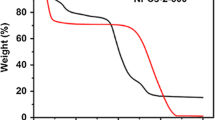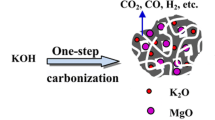Abstract
A porous carbon precursor is prepared by modifying polyvinylidene fluoride with nitrogen via a chemical polyreaction and then introducing mesopores using the soft-template method. After carbonization at the appropriate temperature, the obtained carbon material could be applied in supercapacitors without further treatment. The resulting material exhibits not only a comparatively stable nitrogen content that is very close to the nitrogen content of its precursor but also an effective hierarchical porous structure (~ 0.68 and ~ 4 nm). The large specific surface area of the carbon material (up to 1688 m2 g−1) is also an important factor influencing its excellent electrochemical performance. When tested using 6 M KOH as an electrolyte in a three-electrode system, CN-900 exhibits a specific capacitance of 355.6 F g−1 at 1 A g−1. When tested using the same electrolyte in a two-electrode system, CN-900 shows a specific capacitance of 84.08 F g−1 at 0.5 A g−1. In addition, the carbon material can maintain 98.4% capacitance after 8000 charge/discharge cycles at a current density of 2 A g−1. The performance of CN-900 is further tested in a two-electrode solid-state supercapacitor with sulfuric acid/polyvinyl alcohol as the electrolyte, and a specific capacitance of 90.31 F g−1 is observed at 1 A g−1. Therefore, the nitrogen-modified porous carbon is a very promising material with practical applications in supercapacitors.








Similar content being viewed by others
References
Simon P, Gogotsi Y, Dunn B (2014) Where do batteries end and supercapacitors begin? Science 343:1210–1211
Yan J, Wang Q, Wei T, Fan Z (2014) Recent advances in design and fabrication of electrochemical supercapacitors with high energy densities. Adv Energy Mater 4:157–164
Simon P, Gogotsi Y (2008) Materials for electrochemical capacitors. Nat Mater 7:845–854
Shukla AK, Sampath S, Vijayamohanan K (2000) Electrochemical supercapacitors: energy storage beyond batteries. Curr Sci 79:1656–1661
Zhang LL, Zhao XS (2009) Carbon-based materials as supercapacitor electrodes. Chem Soc Rev 38:2520–2531
Zhou Y, Candelaria SL, Liu Q, Huang Y (2014) Sulfur-rich carbon cryogels for supercapacitors with improved conductivity and wettability. J Mater Chem A 2:8472–8482
Hulicova Jurcakova D, Seredych M, Gao QL, Bandosz TJ (2009) Combined effect of nitrogen and oxygen containing functional groups of microporous activated carbon on its electrochemical performance in supercapacitors. Adv Funct Mater 19:438–447
Hulicovajurcakova D, Puziy AM, Poddubnaya OI, Suárezgarcía F, Tascón JMD, Gao QL (2009) Highly stable performance of supercapacitors from phosphorus-enriched carbons. J Am Chem Soc 131:5026
Wu HB, Pang H, Lou XW (2013) Facile synthesis of mesoporous Ni Co O hierarchical structures for high-performance supercapacitors. Energy Environ Sci 6:3619–3626
Wang J, Liu H, Sun H, Hua W, Wang H, Liu X, Wei B (2018) One-pot synthesis of nitrogen-doped ordered mesoporous carbon spheres for high-rate and long-cycle life supercapacitors. Carbon 127:85–92
Wang J, Liu H, Zhang X, Shao M, Wei B (2018) Elaborate construction of N/S-co-doped carbon nanobowls for ultrahigh-power supercapacitors. J Mater Chem A 6:17653–17661
Hsia B, Kim MS, Carraro C, Maboudian R (2013) Cycling characteristics of high energy density, electrochemically activated porous-carbon supercapacitor electrodes in aqueous electrolytes. J Mater Chem A 1:10518–10523
Chen H, Liu D, Shen Z, Bao B, Zhao S, Wu L (2015) Functional biomass carbons with hierarchical porous structure for supercapacitor electrode materials. Electrochim Acta 180:241–251
Zhu X, Yu S, Xu K, Zhang Y, Zhang L, Lou G, Wu Y, Zhu E, Chen H, Shen Z, Bao B, Fu S (2018) Sustainable activated carbons from dead ginkgo leaves for supercapacitor electrode active materials. Chem Eng Sci 181:36–45
Yu S, Zhu X, Lou G, Wu Y, Xu K, Zhang Y, Zhang L, Zhu E, Chen H, Shen Z, Bao B, Fu S (2017) Sustainable hierarchical porous biomass carbons enriched with pyridinic and pyrrolic nitrogen for asymmetric supercapacitor. Mater Des 149:184–193
Zhang Y, Yu S, Lou G, Shen Y, Chen H, Shen Z, Zhao S, Zhang J, Chai S, Zou Q (2017) Review of macroporous materials as electrochemical supercapacitor electrodes. J Mater Sci 52:11201–11228. https://doi.org/10.1007/s10853-017-0955-3
Wang J, Kang F, Wei B (2015) Engineering of MnO2-based nanocomposites for high-performance supercapacitors. Prog Mater Sci 74:51–124
Wang J, Zhang Z, Zhang X, Yin X, Li X, Liu X, Kang F, Wei B (2017) Cation exchange formation of prussian blue analogue submicroboxes for high-performance Na-ion hybrid supercapacitors. Nano Energy 39:647–653
Wang J, Liu H, Liu H, Hua W, Shao M (2018) Interfacial constructing flexible V2O5@polypyrrole core-shell nanowire membrane with superior supercapacitive performance. ACS Appl Mater Interfaces 10:18816–18823
Li X, Zhang L, He G (2016) Fe3O4 doped double-shelled hollow carbon spheres with hierarchical pore network for durable high-performance supercapacitor. Carbon 99:514–522
Guo H, Gao Q (2009) Boron and nitrogen co-doped porous carbon and its enhanced properties as supercapacitor. J Power Sour 186:551–556
Zhou Y, Ma R, Candelaria SL, Wang J, Liu Q, Uchaker E, Li P, Chen Y, Cao G (2016) Phosphorus/sulfur co-doped porous carbon with enhanced specific capacitance for supercapacitor and improved catalytic activity for oxygen reduction reaction. J Power Sour 314:39–48
Li X, Wei F, Sui Y, Qi J, He Y, Meng Q (2016) Au&Co core-shell nanoparticles capped with porous carbon: high performance materials for supercapacitor applications. Mater Lett 183:408–412
Senthilkumar B, Khan Z, Park S, Kim K, Ko H, Kim Y (2015) Highly porous graphitic carbon and Ni2P2O7 for a high performance aqueous hybrid supercapacitor. J Mater Chem A 3:21553–21561
Yu GH, Hu LB, Liu N, Wang HL, Vosgueritchian M, Yang Y, Cui Y, Bao Z (2011) Enhancing the supercapacitor performance of graphene/MnO2 nanostructured electrodes by conductive wrapping. Nano Lett 11:4438–4442
Guan C, Liu J, Cheng C, Li H, Li X, Zhou W, Zhang H, Fan HJ (2011) Hybrid structure of cobalt monoxide nanowire@nickel hydroxidenitrate nanoflake aligned on nickel foam for high-rate supercapacitor. Energy Environ Sci 4:4496–4499
Zhu J, Xu Y, Zhang Y, Feng T, Wang J, Mao S, Xiong L (2016) Porous and high electronic conductivity nitrogen-doped nano-sheet carbon derived from polypyrrole for high-power supercapacitors. Carbon 107:638–645
Wang D, Fang G, Geng G, Ma J (2017) Unique porous carbon constructed by highly interconnected naonowalls for high-performance supercapacitor in organic electrolyte. Mater Lett 189:50–53
Barzegar F, Bello A, Momodu D, Madito MJ, Dangbegnon J, Manyala N (2016) Preparation and characterization of porous carbon from expanded graphite for high energy density supercapacitor in aqueous electrolyte. J Power Sour 309:245–253
Chen J, Wei H, Chen H, Yao W, Lin H, Han S (2018) N/P co-doped hierarchical porous carbon materials for superior performance supercapacitors. Electrochim Acta 271:49–57
Schopf D, Es-Souni M (2017) Thin film nanocarbon composites for supercapacitor applications. Carbon 115:449–459
Xue T, Xu CL, Zhao DD, Li XH, Li HL (2007) Electrodeposition of mesoporous manganese dioxide supercapacitor electrodes through self-assembled triblock copolymer templates. J Power Sour 164:953–958
Guo N, Li M, Sun X, Wang F, Yang R (2017) Enzymatic hydrolysis lignin derived hierarchical porous carbon for supercapacitors in ionic liquids with high power and energy densities. Green Chem 19:2595–2602
Liu B, Liu Y, Chen H, Yang M, Li H (2017) Oxygen and nitrogen co-doped porous carbon nanosheets derived from Perilla frutescens for high volumetric performance supercapacitors. J Power Sour 341:309–317
Boccaccio T, Bottino A, Capannelli G, Piaggio P (2002) Characterization of PVDF membranes by vibrational spectroscopy. J Membr Sci 210:315–329
Liu J, Shen X, Zhao Y, Chen L (2013) Acryloylmorpholine-grafted PVDF membrane with improved protein fouling resistance. Ind Eng Chem Res 52:18392–18400
Yu JZ, Zhu LP, Zhu BK, Xu YY (2011) Poly(N-isopropylacrylamide) grafted poly(vinylidene fluoride) copolymers for temperature-sensitive membranes. J Membr Sci 366:176–183
Rivas BL, Maureira A, Geckeler KE (2006) Novel water-soluble acryloylmorpholine copolymers: synthesis, characterization, and metal ion binding properties. J Appl Polym Sci 101:180–185
Chang Y, Shih YJ, Ko CY, Jhong JF, Liu YL, Wei TC (2011) Hemocompatibility of poly(vinylidene fluoride) membrane grafted with network-like and brush-like antifouling layer controlled via plasma-induced surface PEGylation. Langmuir 27:5445–5455
Thommes M, Kaneko K, Neimark AV, Olivier JP, Rodriguezreinoso F, Rouquerol J, Sing KSW (2015) Physisorption of gases, with special reference to the evaluation of surface area and pore size distribution (IUPAC technical report). Pure Appl Chem 87:1051–1069
Zheng F, Yang Y, Chen Q (2014) High lithium anodic performance of highly nitrogen-doped porous carbon prepared from a metal-organic framework. Nat Commun 5:5261
Guo S, Shen H, Tie Z, Zhu S, Shi P, Fan J, Xu Q, Min Y (2017) Three-dimensional cross-linked polyaniline fiber/N-doped porous carbon with enhanced electrochemical performance for high-performance supercapacitor. J Power Sour 359:285–294
Portet C, Yushin G, Gogotsi Y (2007) Electrochemical performance of carbon onions, nanodiamonds, carbon black and multiwalled nanotubes in electrical double layer capacitors. Carbon 45:2511–2518
Wang H, Xu Z, Kohandehghan A, Li Z, Cui K, Tan X, Stephenson TJ, King’Ondu CK, Holt CM, Olsen BC (2013) Interconnected carbon nanosheets derived from hemp for ultrafast supercapacitors with high energy. ACS Nano 7:5131–5141
Liu Z, Xiao K, Guo H, Ning X, Hu A, Tang Q, Fan B, Zhu Y, Chen X (2017) Nitrogen-doped worm-like graphitized hierarchical porous carbon designed for enhancing area-normalized capacitance of electrical double layer supercapacitors. Carbon 117:163–173
Shan C, Zhao W, Lu XL, O’Brien DJ, Li Y, Cao Z, Elias AL, Cruzsilva R, Terrones M, Wei B (2013) Three-dimensional nitrogen-doped multiwall carbon nanotube sponges with tunable properties. Nano Lett 13:5514–5520
Yang M, Zhou Z (2017) Recent breakthroughs in supercapacitors boosted by {Wei, 2017#233}nitrogen-rich porous carbon materials. Adv Sci 4:1600382–1600408
Liu B, Yang M, Chen H, Liu Y, Yang D, Li H (2018) Graphene-like porous carbon nanosheets derived from salvia splendens for high-rate performance supercapacitors. J Power Sour 397:1–10
Liu Z, Mi J, Yang Y, Tan X, Lv C (2014) Easy synthesis of phosphorus-incorporated three-dimensionally ordered macroporous carbons with hierarchical pores and their use as electrodes for supercapacitors. Electrochim Acta 115:206–215
Zhou M, Pu F, Wang Z, Guan S (2014) Nitrogen-doped porous carbons through KOH activation with superior performance in supercapacitors. Carbon 68:185–194
Wei H, Chen H, Fu N, Chen J, Lan G, Qian W, Liu Y, Lin H, Han S (2017) Excellent electrochemical properties and large CO2 capture of nitrogen-doped activated porous carbon synthesised from waste longan shells. Electrochim Acta 231:403–411
Wei H, Chen J, Fu N, Chen H, Lin H, Han S (2018) Biomass-derived nitrogen-doped porous carbon with superior capacitive performance and high CO2 capture capacity. Electrochim Acta 266:161–169
Wang J, Liu H, Zhou R, Liu X, Wei B (2019) Onion-like nanospheres organized by carbon encapsulated few-layer MoS2 nanosheets with enhanced lithium storage performance. J Power Sour 413:327–333
Acknowledgements
This work was supported from the National Natural Science Foundation of China (Project Numbers 21606151, 21504057 and 21707092), Shanghai Excellent Technology Leaders Program (Project Number 17XD1424900), Shanghai Leading Talent Program (Project Number 017), Science and Technology Commission of Shanghai Municipality Project (Project Number 18090503800), Shanghai Natural Science Foundation of Shanghai (Project Numbers 17ZR1441700 and 14ZR1440500), Collaborative Innovation Fund of SIT (Project Number XTCX2015-9), Professor of Special Appointment at Shanghai Institutions of Higher Learning (Eastern Scholar), Shanghai Association for Science and Technology Achievements Transformation Alliance Program (Project Number LM201680). Moreover, I am very grateful to my senior schoolmate, Wei Huanming, for helping and supporting my learning and research all the time. And I specially thank my junior schoolmate, Liu Fengru, to assist me in chemical synthesis experiment about this work.
Author information
Authors and Affiliations
Corresponding authors
Additional information
Publisher's Note
Springer Nature remains neutral with regard to jurisdictional claims in published maps and institutional affiliations.
Electronic supplementary material
Below is the link to the electronic supplementary material.
Rights and permissions
About this article
Cite this article
Chen, J., Chang, B., Liu, F. et al. Modification of porous carbon with nitrogen elements to enhance the capacitance of supercapacitors. J Mater Sci 54, 11959–11971 (2019). https://doi.org/10.1007/s10853-019-03748-6
Received:
Accepted:
Published:
Issue Date:
DOI: https://doi.org/10.1007/s10853-019-03748-6




